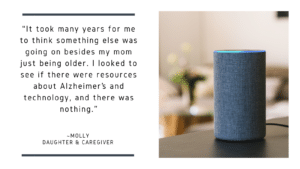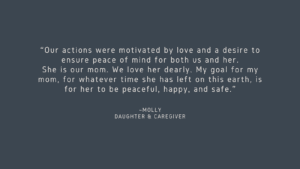
By Meghan McCarthy
Editor’s note: Editor’s Note: In light of the 2024 PennAITech Symposium, this article is a part of ongoing coverage on the intersection of technology and dementia. Names have been changed to protect PMC patient privacy. We sincerely thank the family involved in sharing their story with our community.
Fourteen years ago, Eleanor left her house with a simple afternoon stroll in mind. After the passing of her beloved husband, walks around her gated community were a boost to her daily routine.
Hours later, her daughter, Molly, called Eleanor’s home phone and couldn’t reach her.
“Because she was my father’s caregiver, she always answered her cell phone,” explained Molly. “When I called and asked where she was, she said ‘Oh, I’m very close to home, I’m walking home now.’”
Molly knew something was off. It was pitch-black outside and with the recent snowfall, the scenery looked different. Additionally, Eleanor is not fluent in English, creating a language barrier if she needed help.
Anxiety ensued.
Molly navigated through the roads of Eleanor’s gated community but found no trace of her. Molly even reached out to the community’s security center, but to no avail. With Eleanor still missing, Molly was left with no choice but to call 911.
“When the police found her, she was very far away and absolutely out of her gated community,” said Molly. “She was walking on a street with many cars coming and going. She was still walking and completely believing that she was walking home.”
Faced by uncertainty about her mother’s cognitive condition, Molly was certain she never wanted to feel that level of panic again. In the following years, Eleanor was diagnosed by Jason Karlawish, MD, co-director of the Penn Memory Center (PMC), with Alzheimer’s disease (AD).
“It took many years for me to think something else was going on besides my mom just being older,” said Molly. “I looked to see if there were resources about Alzheimer’s and technology, and there was nothing.”
After her mother got lost, Molly called her phone service provider and asked if there was a way to track Eleanor’s cell phone. In 2010, this was no easy feat as live location sharing and tracking apps had not been developed yet.
The phone service provider offered the Secure Family Today program, which allowed Molly to track Eleanor’s flip phone. Without requiring her mother to even download an app, Molly relied on the technology to ensure her mother’s safety while living independently.
“It was like magic,” said Molly. “The service cost $9 a month, and what a relief that was.”
With this newfound peace of mind, Molly slowly incorporated more technological solutions into her mother’s caregiving routine.
Except for Molly, Eleanor’s children lived outside of Pennsylvania. The family tried video-calling Eleanor through her iPad, but it was challenging. Eleanor struggled to navigate the device and, due to hearing loss, even hear its alerts.
The family opted for a first-generation Amazon Echo. Once Eleanor authorized her children to call her through the device, they could effortlessly ‘drop in’ for a chat without needing Eleanor to physically answer the call.
The system allowed Eleanor to remain connected to her family without needing to remember how to use a new device.
As her AD symptoms progressed, it became increasingly risky for Eleanor to live on her own. In some occasions, for example, she would forget to turn off a stovetop after cooking.
In response, Molly and her siblings upgraded Eleanor’s home technology system. They installed Ring cameras in key locations, including the kitchen and entrance, to monitor their mother’s safety closely. Using the Ring, they also customized doorbell alerts to chimes, making it easier for Eleanor to hear them despite her hearing loss.
To assist with their mother’s confusion over remote controls, they equipped her television with technology that enabled them to change the volume or channel. They also purchased a remote specifically designed for older adults, with fewer button options.
During power outages, Eleanor found the disruption of routine, like the television and lights turning off, confusing. To address this, her family installed a generator that automatically activates whenever there’s a loss of power.
Technology extended Eleanor’s ability to live independently. However, as her condition evolved, Molly and her family realized a more substantial change was necessary.
“Towards the end of her time at home, she began hearing voices,” said Molly. “She would open the garage door, believing that my brother and kids were coming. It became dangerous. Even though we could close her garage door remotely, she would hear voices again and just reopen it.”
In choosing a living facility, Eleanor’s family considered which ones would accommodate technological modifications.
“Not every facility is keen on having cameras in their rooms,” said Molly. “Our intent was never for the cameras to impact how her care, but rather to enable us to stay in touch with her and monitor her well-being.”
In Eleanor’s new space within the assisted living facility, Molly installed an Amazon Echo device equipped with a camera that pans across her room. This setup allows Molly to check on Eleanor’s environment and daily routine without regularly intruding on her space.
“Due to the language barrier, it is hard for the staff in her living facility to communicate with her,” said Molly. “I visit every day but can’t be there all the time. She was skipping meals. Now, I call her 30 minutes beforehand to ensure she’s prepared to join her friends.”
The Echo device also allows Molly to locate where Eleanor places items.
Reflecting on her mother’s journey with AD, Molly identifies Eleanor’s walk as a catalyst for change.
Eleanor may have gotten lost 14 years ago, but the incident led Molly to discover new ways to support her mother’s aging journey.
“Our actions were motivated by love and a desire to ensure peace of mind for both us and her,” said Molly. “She’s our mom. We love her dearly. My goal for my mom, for whatever time she has left on this earth, is for her to be peaceful, happy, and safe.”
